Back in the 1990s the TNC2Q got famous for packet radio. TNC2Q which was build by DF9DQ and distributed by OV O28 in those days. As a member of O28 I was in the lucky position to build one TNC2Q my own. That was the start of my ham radio hobby. "More than 20 years later, the revival of packet radio - the new packet radio - is here. F4HDK did a great job, so lets support this." were my thoughts last year. It took too long, but now I can share my new project, the NPR-H.
I started to create a wish list.
- To reduce RF cables it would be good to have the modem close to the antenna, so I decided for a network interface including PoE. Any standard PoE Port or injector can run the modem.
- An external PA and setup is a bit clumsy, so i wanted an internal PA. On 70cm, 1 .. 5 Watts would probably be enough, so I decided on a power amplifier chip.
- An LNA is also good to have, so lets go with that in ISM Band.
- To be compatible, the MCU and RF Chip Si4463 must be the same.
- Because of high power would probably need an RF switch that is capable of switching 10 Watts without too much insertion loss.
After a lot of research, appnotes, I created a hardware. Well... this is not the first, probably also not the last, but the (for now) final one which fulfills my wish list.
PCB Model
On the lower left, you can see the magnetic ethernet jack, which splits PoE and Ethernet. The lower part is the entire power supply. Top left is the network area, middle the MCU area and top right the RF part.
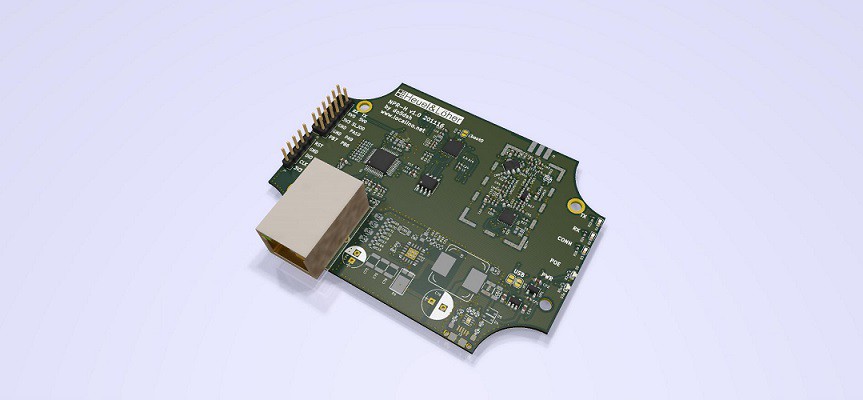
I ordered the PCBs, got them 2 weeks later and then... well... had to assemble it. Its not my favourite part, but it had to be done. Its good to have one of those days where you cannot not sleep well... and as "the early bird catches the worm", I got up in the middle of the night and started to build it.
During night...
During these times, I enjoy building things. Very few people are awake, there is no noise, there are no cars driving around. I switch on music at low volume, listen to it and have all night long to build it. There is no rush, there is no one calling me, asking me anything, no emails, no signal messages...
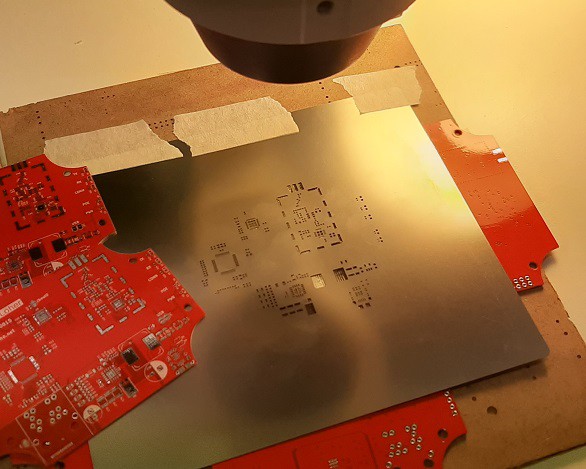
After more than 200 SMD parts I checked the PCB once more. Tuned the music to Dire Straits and backed the whole thing. I have my own little oven to do so. Its covered with chamotte, so it keeps the heat very well. A K-type temperature sensor feeds the actual temperature to a control board which regulates AC voltage. After approximately 400 seconds the process ends, and I could assemble the remaining non-SMD parts.
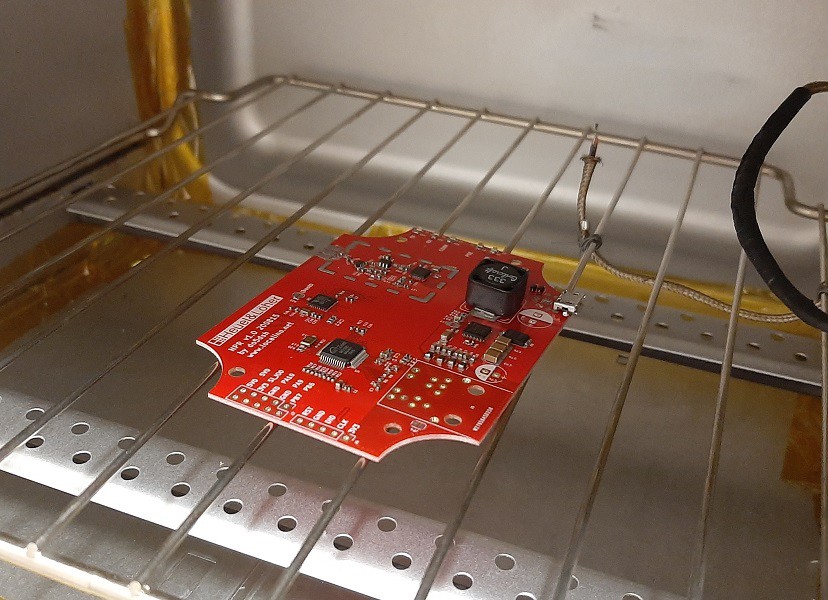
First Tests...
I checked the voltage, current consumption, connection to STM, measured the RF parameters like S-Parameters, and flashed the firmware. But... nothing happend. LEDs were on, but other than that: SILENCE.
What happend? As I knew not much about the firmware yet, I started to dig into that. Did a lot of debugging and realized that the network PHY/MAC controller was not connected properly. So I had to fix that.
...well this sounds like:
12:01 PM "damn, its no working."
12:02 PM "well lets fix it."
12:05 PM "oh, its that issue" - "lets fix it" -
12:10 PM "done."
but its actually not. It was a pain. It took me several days to realize the missing connections on my PCB. The reason was not me working at night or beeing too unconcentrated, it was ambiguous information in the data sheets and appnotes. And I just saw the wrong one...
Make a second one...
Well, back to topic.
After I made one work, I made a second one work. Because NPR requires one master NPR-H and one client NPR-H. So I connected each one of them to a PC with DHCP network interface and pinged each other. Success!
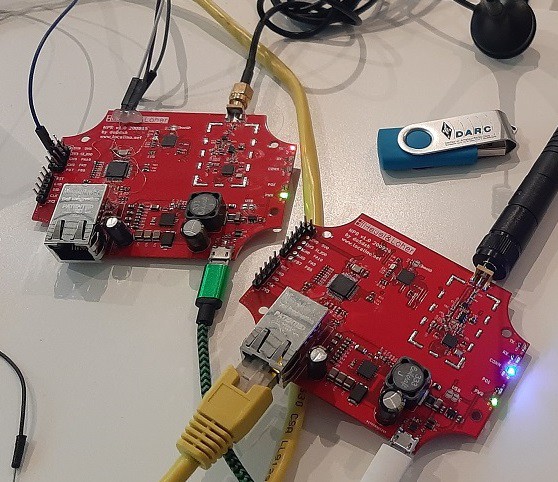
Make a another revision with PA...
After I made it work I revised the version and added a power amplifier. That PA has an op1dB of 29 dBm. Measuring and optimizing the S-Parameters brought the TX power to 25 dBm output. The LNA gain is set to 13 dB. In this screenshot you can see the second harmonic to be lower than 53 dBc when measured via direct RF connection. This should not be an issue when using an antenna for 70cm band.
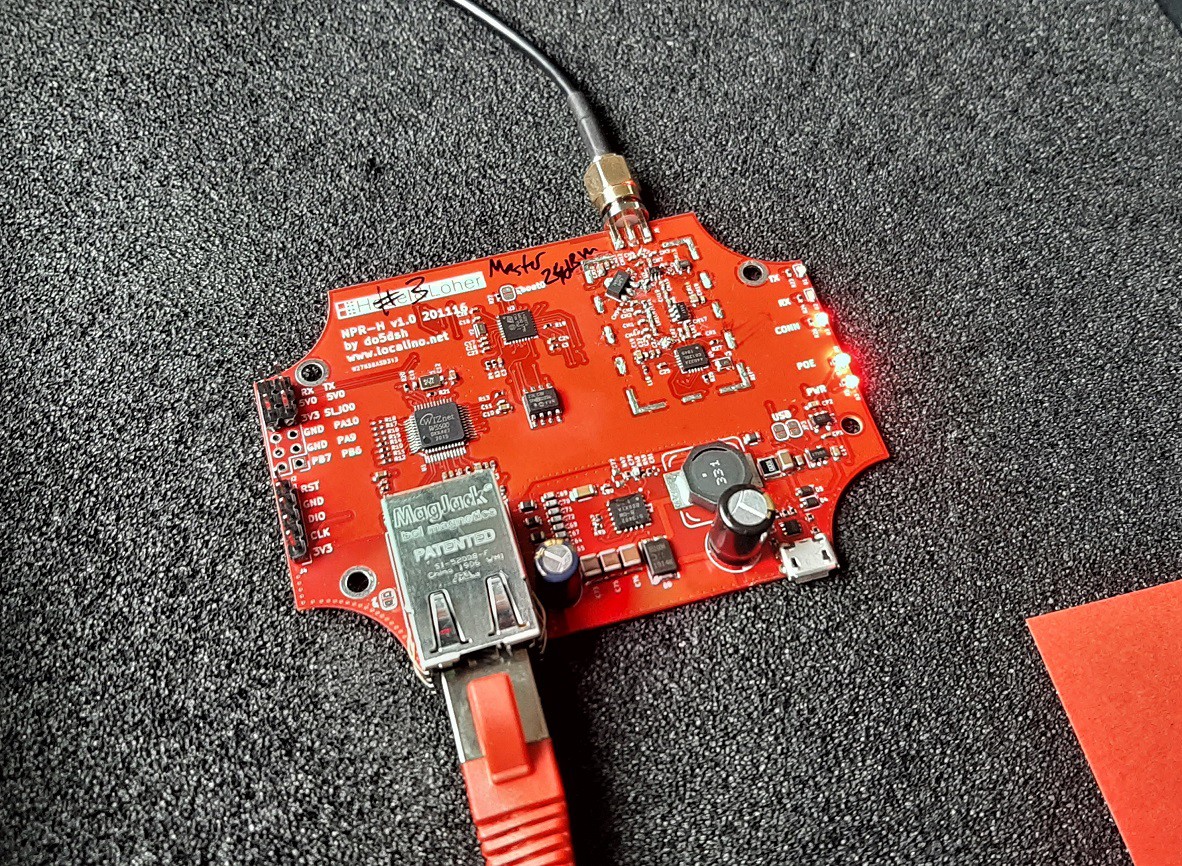
Spectrum measurement with Rohde & Schwarz ZNL3
I connected my NRP-H to the spentrum analyser, ehhm... network analyser... ehm, ZNL. Not sure R&S calls it Network Analyser, but it can do both: spectrum measurements and 2 port network analyser measurements... besides power measurements or noise figure.
I optimized NRP-H using the NWA functionality first and then did spectrum measurements. To do so I used 9 dB attenuation due to the high power of the NRP-H. The measurement device can handle up to +27dBm, but I did not want to risk anything. In the measurements you can see a 9dB offset therefore.
In the figure below you can see the entire specturm up to 3 GHz. Two harmonics with >53 dBc are visible.

To measure spectrum make sure to use the right RF (Port 2) connector otherwise you may search for the signal in spectrum after you did the S11 measurements.
I did S-parameter measurements of the RF Input and LNA gain. I connected the NRP-H antenna port to Port 1 and soldered a short pigtail behind the LNA which I connected to Port 2. You can see the S11 in the top trace and LNA gain in the lower trace. The span is 5 kHz to 3 GHz, S11 < -10dB is between 360 MHz and 535 MHz. The LNA gain is 13 dB.
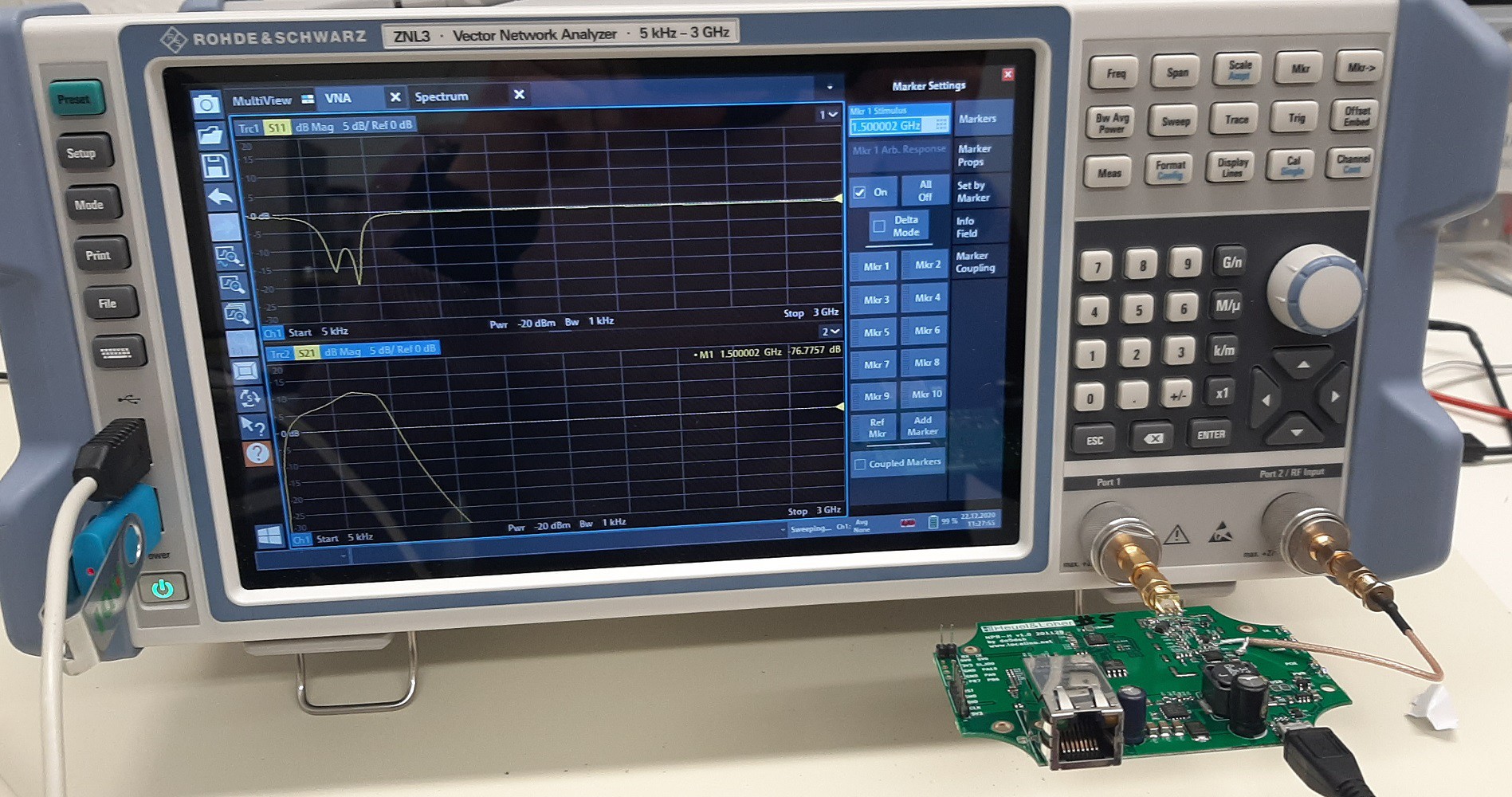
Spectrum and OBW
In germany we have 200 kHz of spectrum available for Packet in 70cm band. I selected mode 20 which uses 4 GFSK and has a raw data rate of 100 kbps. The measured OBW is 90 kHz (used 10 kHz RBW).
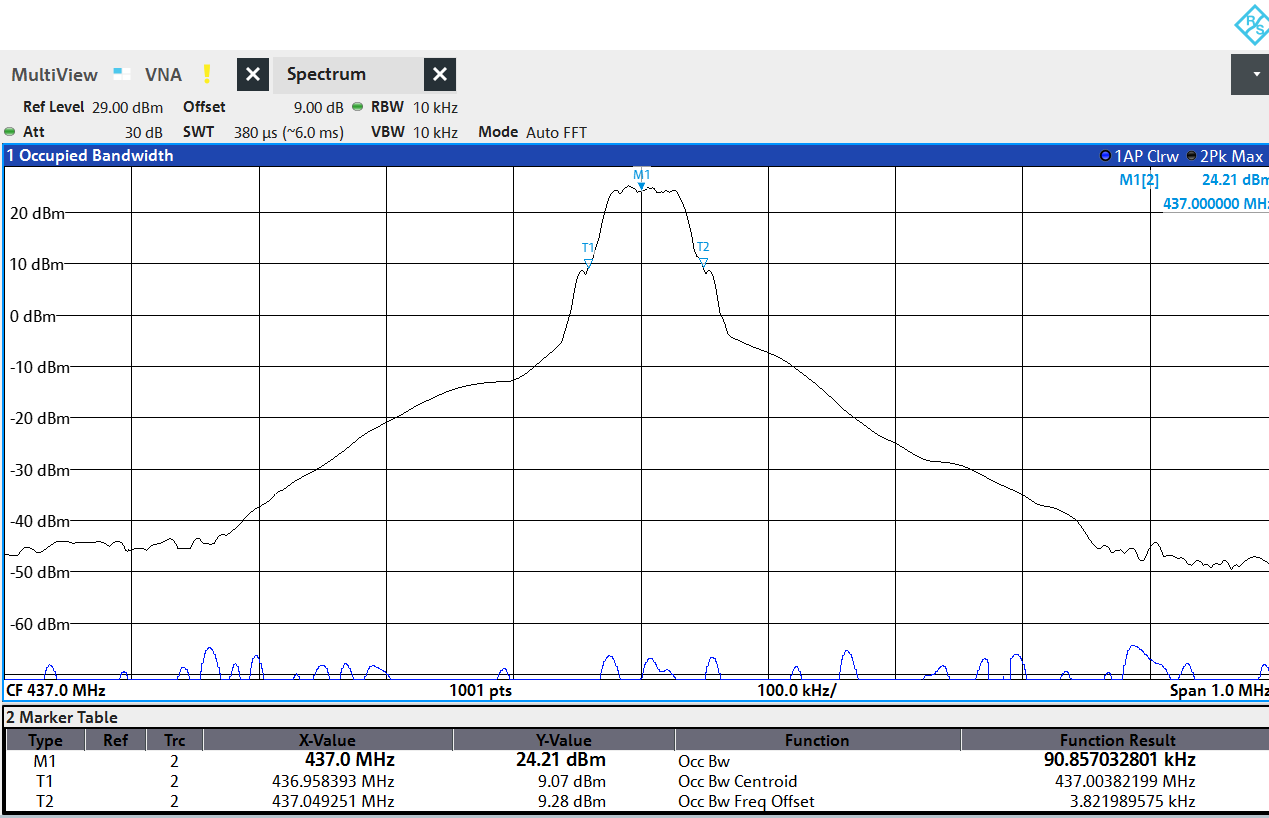
Performance...
How fast is NPR-H?
I setup the two NPR-H at different location, a few hundred meters apart and started with a 10.7 MB PDF file ("Funkbuch") which got transferred with up to 500 kBit/s. Success. In germany 200 kHz bandwidth is allowed so there is a special setting in the firmware to set modulation and to reduce data rate to fit into 200 kHz bandwidth with -20dBc.
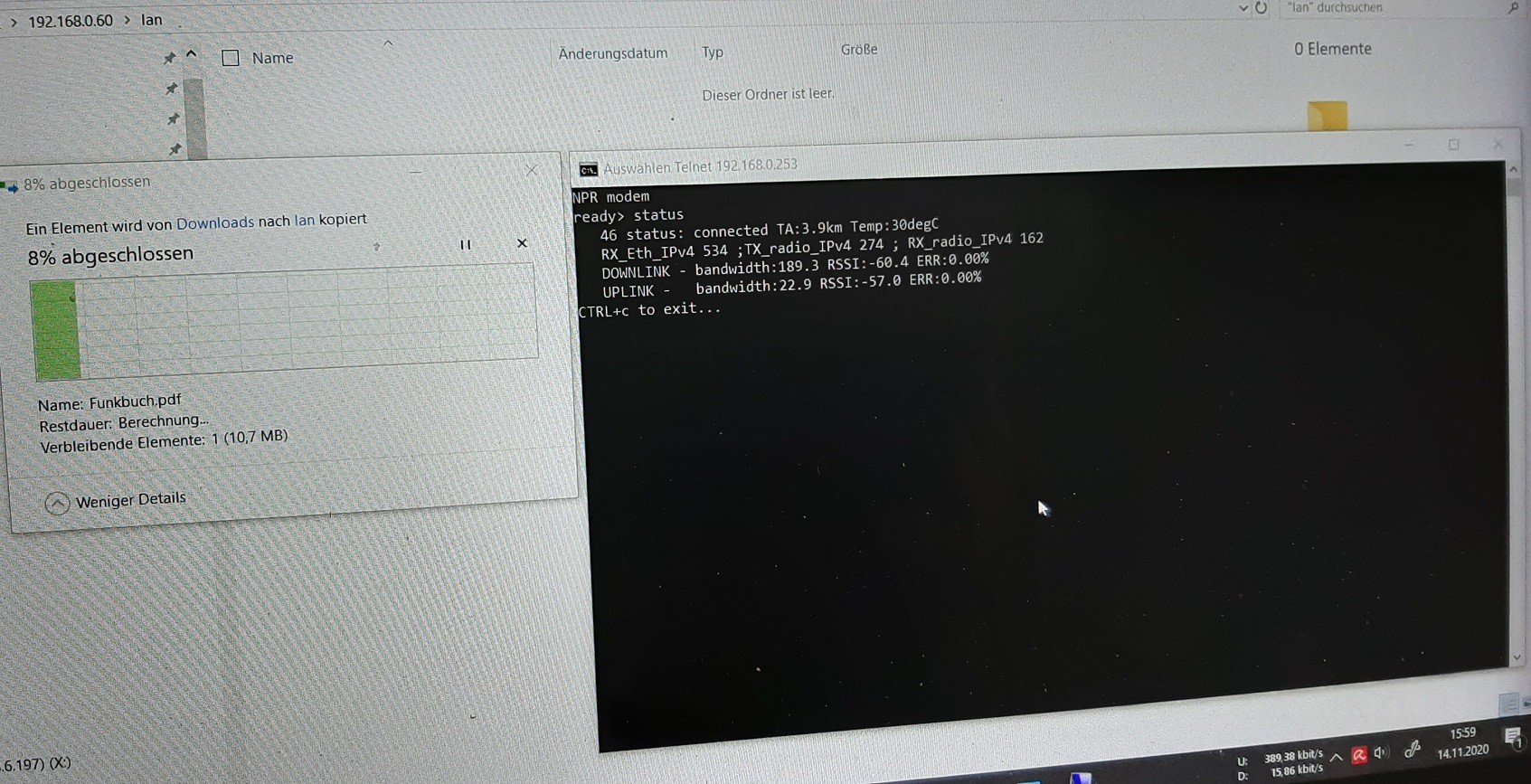
Enclosures.
I had enclosures lying around from other hardware, this NPR-H fits well here. But I have desiged it in that way, that we can use standard HENSEL IP67K enclosures which can also hang outdoors. So a single network cable feeds the NPR-H which is close to the antenna and connected to the SMA.
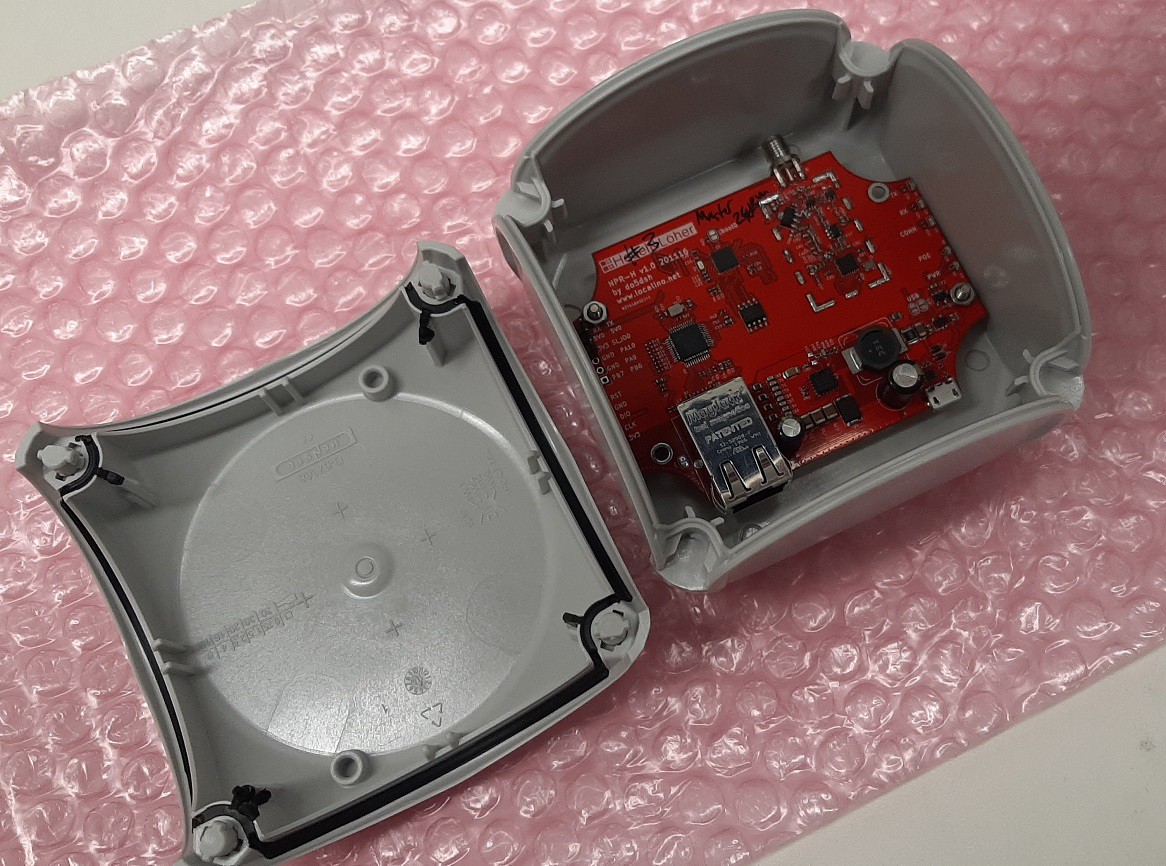
Noise Figure Measurements (Update 29.12.2020)
Another cool thing about the R&S ZNL, it can also measure Noise Figure (NF)! A low NF is important to have good sensitivity and reach long distances. The Si446x chips have a typical noise figure of > 6 dB in 70 cm band according to Silabs forums. Thats typical for these transceiver chips.
To measure the Noise Figure of my hardware I calibrated the Noise source and then connected it to the antenna port. The Port 2 (RF In) was connected to the output of the LNA.
The measurement results shows a Gain of 13 dB with a Noise Figure of 1.3 to 1.5 dB in 70 cm band. That is a good result which promises nice sensitivity! So lets measure sensitivity next!
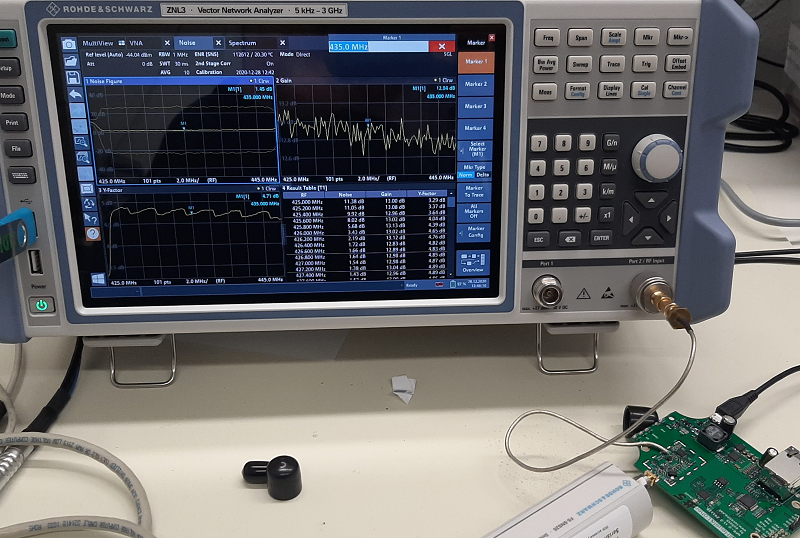
Sensitivity (Update 29.12.2020)
The most important question: Which distances can I reach with NPR-H? What is the link budget? To measure I have thought about to record and replay the signals and then check the sensitivity level at first. But its more convenient to connect Master and Client via a variable attenuator and check the packet error rate.
My setup was as follows:
Master (0dBm Tx power) <--> variable attenuator 0.. 110 dB <--> Client (25 dBm Tx power) -> PC
The idea is to measure packet error rate at the client side. That master will definitely hear the client as its 25 dB louder than the master itself. A bad link level will keep the connection but will result in an increase in packet error rate at the "downlink".
I set the attenuation to 50 dB at first and measured good signal without any issues, increased to 60dB and still measured good signal... so I went on. Finally, increasing this to 101 dB started to produce reception errors as you can see in the realterm figure below. You have to add the 13 dB LNA gain to the RSSI figures, that will give you the real RSSI of approx -100dBm .. -101 dBm at this point.
If you compare now to the existing NPR, the new NPR-H is 3dB to 12dB more sensitive compared to the existing one.

in the description from F4HDK the existing hardware is measured as stated below in the table. The new hardware including LNA, PA, PoE etc shows 0% ERR at -99 dBm, so its much more sensitive and can reach longer distances (remember that 6 dB doubles the distance!).
| Modem | NPR from F4HDK without Preamp | NPR from F4HDK with VR-P25D Preamp | NPR-H (NPR modem) from DO5DSH |
| Sensitivity Mode 21 | -87.7 dBm | -95.5 dBm | -99 dBm |
Next steps
There are additional tests to come, additional hardware performance measurements are planned. If you are interested in a assembled PCBs, please get in touch with me or check on tindie.